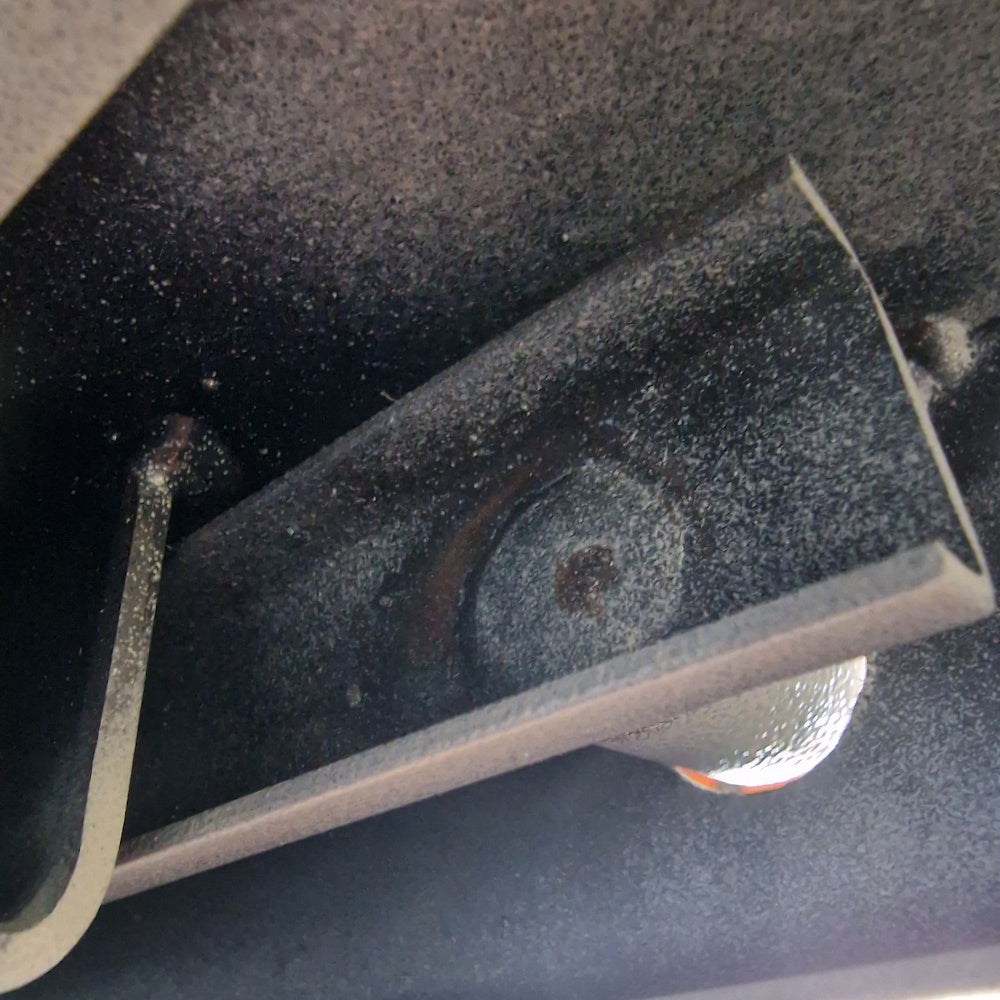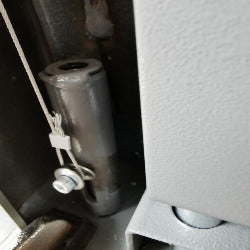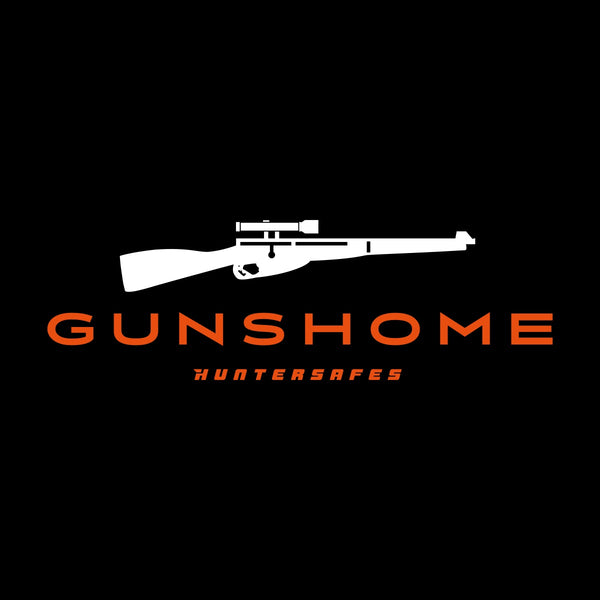Gun safe in the test: The test criteria for the gun safe test
We will now describe the individual testing criteria that gun cabinets must meet.
A lot of technology, but for your better understanding we have illustrated the respective points as clearly as possible.
You see good and not so good solutions.
Decide for yourself what is important to you:
Packaging/transport protection:
To ensure that your gun safe arrives properly, it should be properly packaged.
A stable pallet, a reasonable cardboard box, foil-wrapped outer packaging and additional protection for protruding cabinet elements are crucial if transport damage is to be excluded as far as possible - which of course does not necessarily work in every case, as the photo proves.

Pictured: Transport damage despite additional bubble wrap:
Box is torn open
Foil is punctured
Paint damage to the safe



Handle fittings:
Type and design of the door handle:
Metal door handles are more stable and durable than plastic ones, which can often break during use. This makes operation more difficult and leads to unnecessary costs for handle replacement.
 Pictured: Metal folding handle of the SHOOTER model.
Pictured: Metal folding handle of the SHOOTER model.
Mounting options:
The more anchoring options you have in the floor and/or the back wall, the better it is for you, as it gives you more flexibility when anchoring .
Any anchoring material supplied is also advantageous, but its suitability should always be checked.
The decisive factor here is the material in which the anchor is used, and for each material there are anchoring devices that are suitable or unsuitable.  In the picture: double lower rear wall drilling and double floor drilling in the HUNTER gun cabinet.
In the picture: double lower rear wall drilling and double floor drilling in the HUNTER gun cabinet.
Locking bolt connections:
Door security: in words and pictures, what you can do without:



We already looked at the problem in detail above: the locking bolts are attached to the locking rods with simple clips. If a bolt comes loose, the cabinet can no longer be opened, as this bolt is not pulled back into the door after locking and simply remains stuck outside, continuing to lock the door. It's hard to identify such a hidden weakness more clearly and document it with photos!
So things can be better. Here's what you shouldn't do without:


Bolt guides - locking bar guides:

Pictured: locking bar / Locking bar guide in the ISS Lucerne
To make it "better," the crooked guide pin is hammered during assembly, but this doesn't have a lasting impact:

Pictured: hammered guide pin for guiding the locking bar, ISS Lucerne
Bolt guides:
The bolt's passage through the door frame is an important factor in determining whether a bolt system runs smoothly or jams. If a bolt runs crookedly in the bolt guide, it usually jams, meaning the bolt system becomes stiff. As you can imagine, this has long-term consequences for users:

Pictured: Bolt guide in ISS model, see red arrows, no words. (Sorry, but such a botched job was only documented photo-graphically; the manufacturer is still responsible for production and quality control.)
When, for some inexplicable reason, the smooth operation doesn't work, some mechanics are tempted to express their anger with a hammer. However, one shouldn't unleash one's unbridled strength on a locking bolt, as this can sometimes cause a safety clip to pop out of the bolt groove, as we saw above:


The central element: the locking center:

Pictured: Bolt center with toothed gear (front view without boltwork cover plate) found in the Shooter and Hunter models.

In the picture: disassembled boltwork with pressed-in locking pins
Especially with pressed-in locking pins in self-made locking units, often exacerbated by other causes of stiffness in the locking bars, it can be observed that the pins become loose or eventually break out, making the locking bar in question impossible to move. This makes the cabinet impossible to open without brute force, resulting in total loss!

Pictured: locking center with pressed-in locking pins (view from above), ISS / identical to Format-Eisenbach.
Security for lock and hinges:
Hinges:
Removable hinges make transporting the door to the desired location easier for the customer. If similar materials rub against each other, they will wear each other down. A design separation is therefore necessary, as otherwise the door will sag over time due to mutual wear and eventually hit the casing, which then leads to serious locking problems. A height adjustment on the hinge can be used to adjust the door's sagging. However, this is only absolutely necessary if no other precautions are provided for abrasion protection.

Pictured: removable hinge from the discontinued GUNTRESS model, with brass ring as abrasion protection.


Why we buy a gun safe:
the gun owners:
Weapon holder material:
The weapons should be stable and the weapon holders must not damage the weapons themselves or be damaged by use.
With foam gun rests, individual pieces sometimes break off after a while, which can limit the use of the rest at that point. A factory-applied rubber coating can remedy this.
Weapon holder width and depth:
The dimensions of accessories such as scopes or night vision attachments determine the space required for each weapon.
Therefore, the width must be adjusted to ensure the distance from the barrel center of one weapon to the barrel center of the next weapon, so that the next storage space doesn't have to remain empty, which would reduce capacity. Only 60mm or more is suitable.
The height of the accessory assembly, including mounting rails, from the top edge of the barrel determines the required depth. 80mm or more is recommended.
Adequate shaft protection on the ground should be effective.
Let’s look at what solutions are available:
Wooden weapon holder, felted

Pictured: fixed weapon holder from the (discontinued) GUNTRESS made of wood, felted.
Foam block - weapon holder

Pictured: Foam block - weapon holder in format / Eisenbach Capriolo

In the picture: the rubberized foam block of the SHOOTER model achieves the necessary minimum dimensions in terms of weapon spacing and adjustment depth.
Three-dimensionally adjustable weapon holders:

Pictured: GUN-i-FLEX weapon holder from the HUNTER model.
Storage options: shelf, door storage box, shelf section:



Accessories and other evaluation criteria:
Key bar:
Key racks are practical, but not an absolute must-have. Individual key hooks can also be retrofitted inexpensively as accessories.

In the picture: hook rail for keys.
Holder for cleaning rods:
Permanently installed cleaning rod holders are nice, but they also take up a lot of valuable space.
There are now magnetic cleaning rod holders (in our accessories section), a cleaning rod can also be stored outside the gun cabinet, which creates a lot of free space for storing other items that have to be kept IN the gun cabinet.

Pictured: Cleaning rod holder from GUNTRESS.

Now that you know our testing criteria, which we apply consistently to all test subjects, here are the test results:
Gun safe test: Gunshome, model Shooter
Gun safe test: Gunshome, model Hunter
Gun safe test: Format Tresorbau (Eisenbach safes), model Gun Safe / Capriolo
Gun safe test: ISS (Hartmann, Frankonia, Bremer, Waffenschrank...etc), model Luzern
Gun safe test: Burg Wächter (various hardware stores), model Ranger N5S
